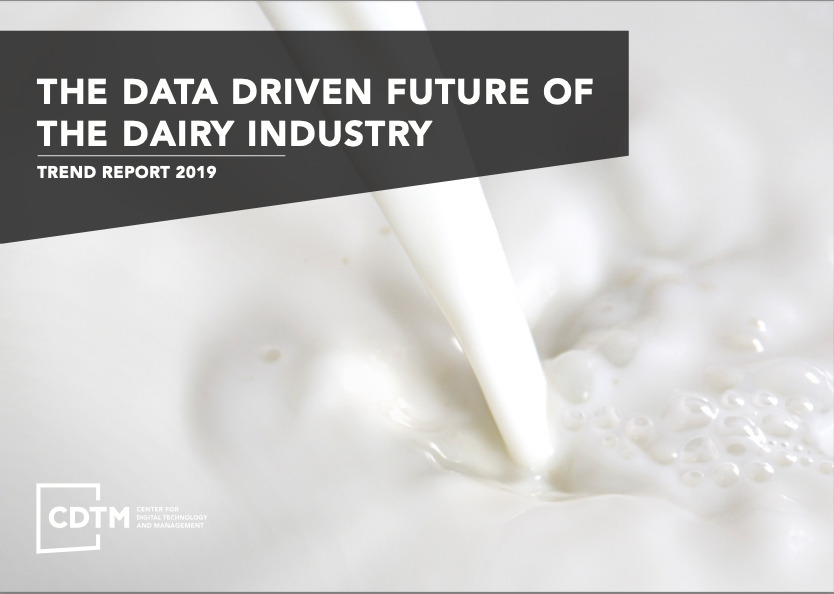
The data-driven future of the dairy industry
Abstract
Dairy farmers and Dairy processors are facing a grow-ing demand for milk and milk products from a rising, and increasingly urbanized world population, a growth of the middle-class and a change in food patterns against a back-ground of higher quality requirements, animal health and production standards. With such an increasing complexity in the dairy business, new technologies – such as the Internet of Things (IoT), Big Data Analytics and Computer Vision – provide an ideal starting point to enable the shift towards a data-driven future of the food chain from farming via processing to retail.This opens up new potentials for more efficient and sustain-able milk production and pro-cessing on the one hand and new business opportunities for farmers and process suppliers on the other hand. But which technologies are best suited for shaping the future of dairy? Which data is available and accessible for further utilization and potentially contributes to new business models? How will the urban-rural environment be shaped by digital technologies? How could a cow-friendly and sustainable farm of the future look like? And what are the implications for dairy farmers, dairy processors and their suppliers in Germany and abroad? This report identifies current trends that affect the future of the dairy business until 2039 and derives four future extreme scenarios as well as five related business ideas.
TRENDS
"Market Structure": Market structure can lead to high fragmentation or high hor- izontal consolidation of the market and consequently affect companies on each step of the value chain. On one end of the market structure spectrum, fragmentation results in a significant increase in the number of players within the dairy market. Local market forces, such as strong regional demand could lead to fragmentation. In contrast, consolidation de- creases the number of players within the dairy market and creates an oligopoly. Global market forces, such as continu- ous price pressure could lead to a highly consolidated market. These outcomes have an impact on the negotiating power of players as well as their ability to invest in new technologies and may fundamentally change the market dynamics. The following paragraphs examine the extreme outcomes of mar- ket structure within the dairy market. Outcome A refers to a fully consolidated market operated by solely international companies. Outcome B, however, describes a fully-fragment- ed market with a focus on regional milk production.
"Consumer Choice": In this report, the focus lies on the extent to which the dairy products will coexist with the emerging dairy substitutes. This development is mainly influenced by two factors: cus- tomer mindset regarding product selection, and which dairy or non-dairy products are offered on the market. Each cus- tomer attaches different grades of importance to product characteristics such as environmentally-friendly and ethical production, brand, nutritional value, and price. Besides dairy products, other non-dairy substitutes are gaining significant market share. Nowadays, alternatives to dairy consist mainly of plant-based products, while “synthetic milk” containing artificial proteins, i.e. by cows or insect-based, might become technologically and economically feasible in the future.
“noCow Inc.” draws a picture of consumers who only demand non-dairy substitutes instead of traditional dairy products. Due to economies of scale, the industry is highly consolidated with few key players dominating the markets of each continent along the entire value chain from production to distribution. In “Daily Dose of Dairy”, only a few large producers meet the demand for dairy on a continental level. Dairy substitutes make up only a small niche market in this scenario since it has grown less attractive. “Good ol’ Dairy” describes a scenario in which people stick to their original love for dairy products. Technological advancements, strict environmental and animal welfare regulations fostered small, sustainable farms, with some of them even having integrated processing facilities. In “Generation Local”, increased global environmental awareness due to natural disasters has led to a sole demand for non-dairy substitutes. The market is fragmented, as high carbon taxes on transportation and governmental subsidies support local, small-scale production.
Business models
1. VET.IO: Keeping your farm animals healthy
2. ACADAIRY: Educate. Accelerate. Connect.
3. DUNG DEAL: The marketplace for farmers to trade transparently and cost-effectively
4. MILQ: streamlines milk procurement interactions between dairy processors, farmers, and logistic companies
5. MOOMENT: Your cows' health at a glance


